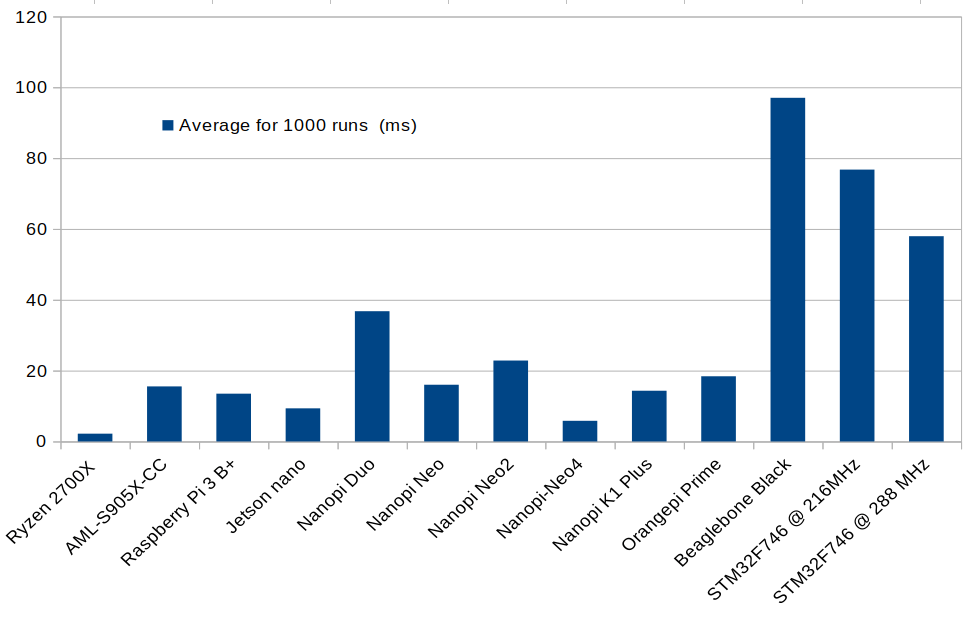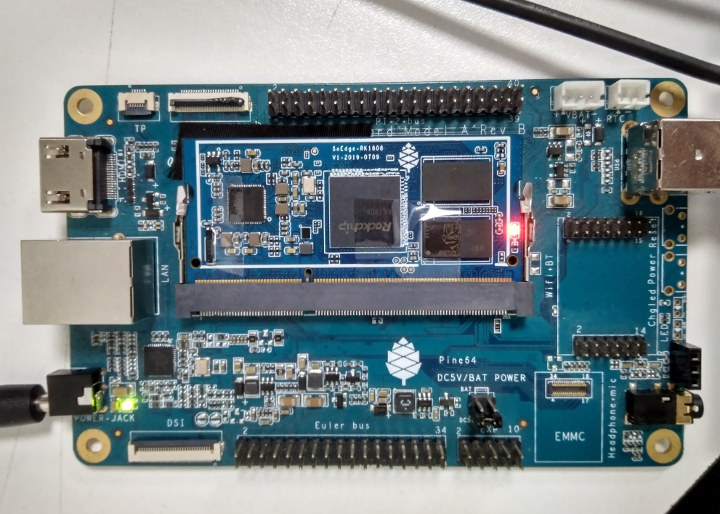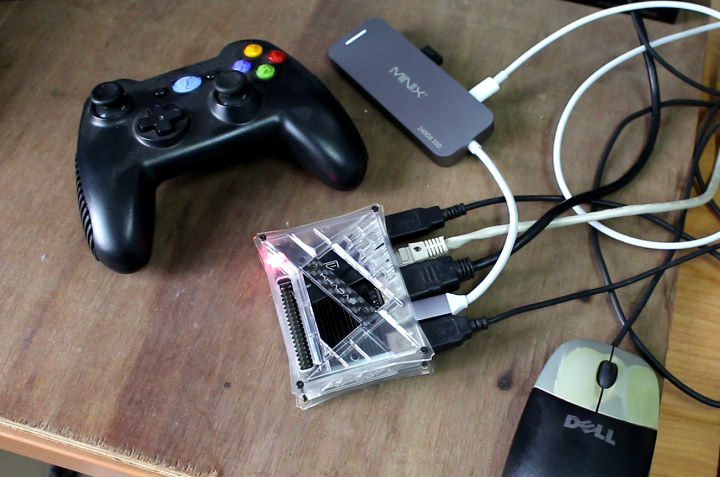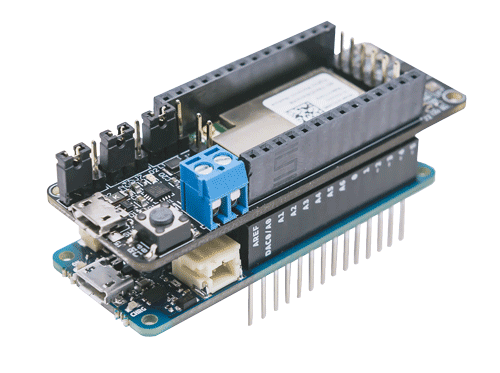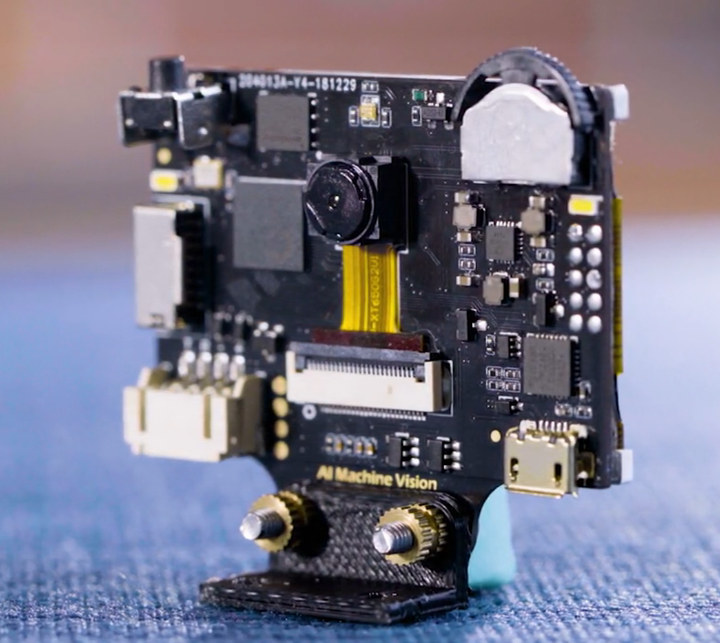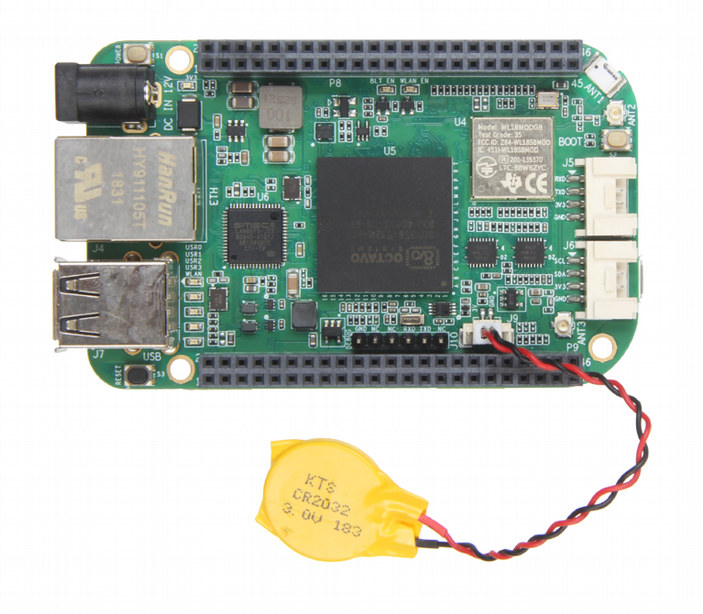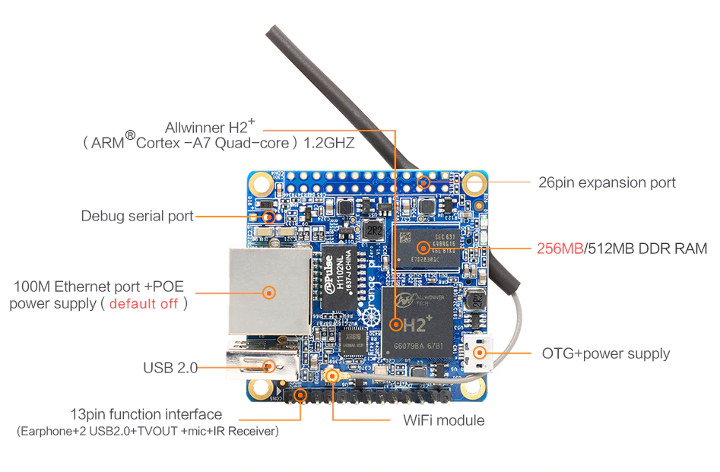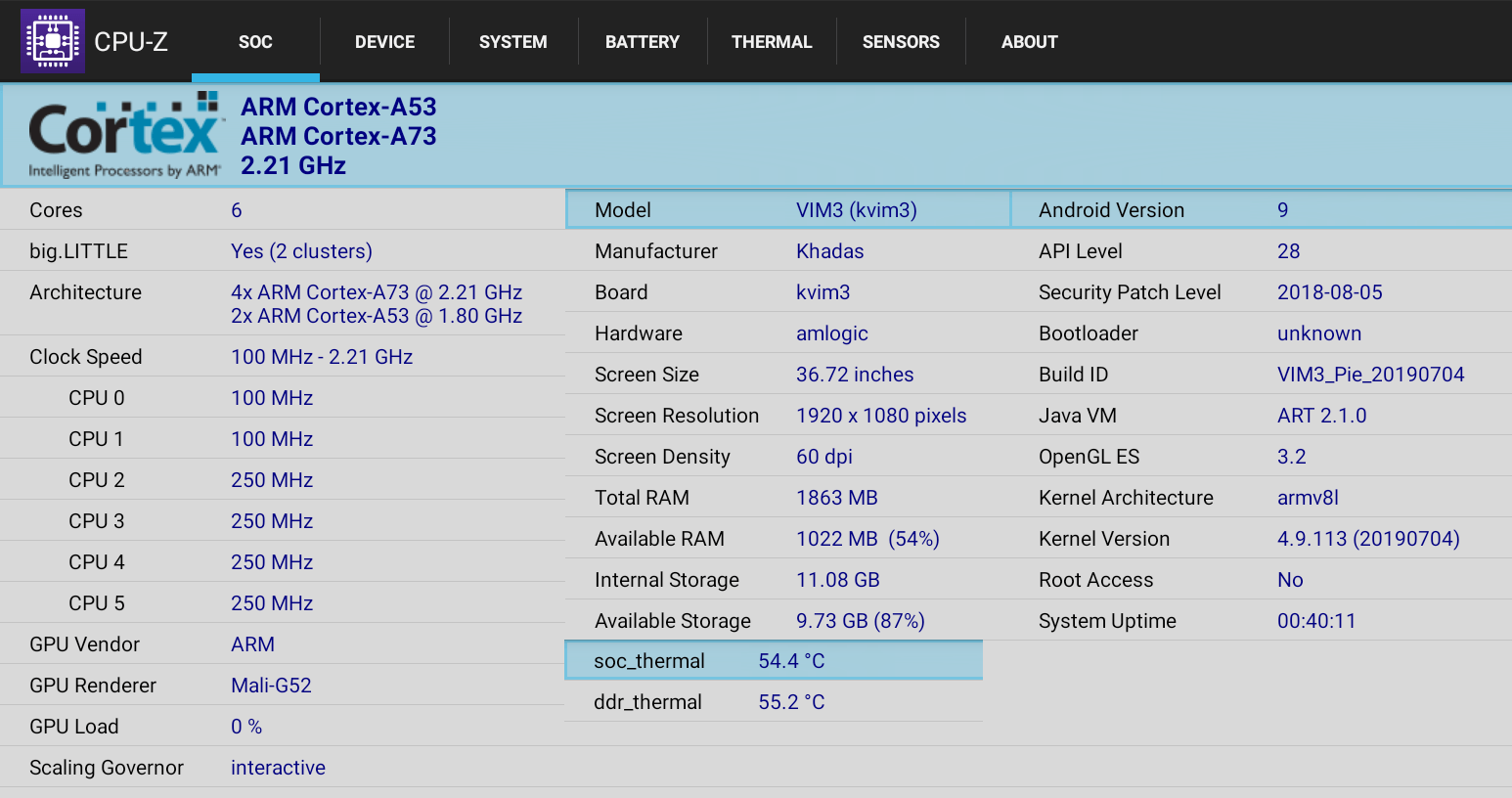Dimitris Tassopoulos (Dimtass) decided to learn more about machine learning for embedded systems now that the technology is more mature, and wrote a series of five posts documenting his experience with low-end hardware such as STM32 Bluepill board, Arduino UNO, or ESP8266-12E module starting with simple NN examples, before moving to TensorFlow Lite for microcontrollers. Dimitris recently followed up his latest “stupid project” (that’s the name of his blog, not being demeaning here :)) by running and benchmarking TensorFlow Lite for microcontrollers on various Linux SBC. But why? you might ask. Dimitris tried to build tflite C++ API designed for Linux, but found it was hard to build, and no pre-built binary are available except for x86_64. He had no such issues with tflite-micro API, even though it’s really meant for baremetal MCU platforms. Let’s get straight to the results which also include a Ryzen platform, probably a laptop, for […]
Pine64 SoEdge-RK1808 AI Module Delivers 3.0 TOPS via Rockchip RK1808 SoC
A few weeks ago, Ameridroid reported Pine64 would soon launch SoRock and SoEdge systems-on-module, but at the time there was virtually no info except SoRock would be likely based on either RK3328 or RK3399 and work on the existing Clusterboard, while SoEdge would be an AI Neural module for Artificial Intelligence tasks, with up to 3 TeraFLOPS of performance. I did not write about it at the time, simply because there was so little information, but this morning I’ve just received some photos of SoEdge-RK1808 module fitted to a baseboard that looks to be SOPINE Model “A” carrier board. SoEdge-RK1808 SoM Let’s try to derive the specifications from the photos even though some components appear to be blurred out or just unclear: SoC – Rockchip RK1808 dual-core Cortex-A35 processor with 3.0 TOPS NPU (Neural Processing Unit) System Memory – 2GB RAM (2x 8GBit Micro DDR4-2400) but limited PC-2133 Storage – […]
Android Gaming on Khadas VIM3 SBC (Video)
I started playing with Khadas VIM3 Basic SBC powered by Amlogic A311D processor and 2GB RAM, and noticed Android benchmarks, especially 3D graphics were significantly better (40% improvement) than the ones of Rockchip RK3399. So I decided it may be interesting to show Android gaming on the single-board computer, and installed the latest version of Android 9.0 with Google Play store. Finally I connected the RF dongle of Tronsmart Mars G01 wireless gamepad, as well as USB keyboard and mouse to get some fun. Since the board only has two USB type-A ports, I also inserted MINIX NEO S2 USB-C + SSD hub to connect the gamepad RF dongle. Then I tried to install and play four games Beach Buggy Racing Installed via Google Play Played with Tronsmart gamepad. Perfectly smooth with max graphics settings. Similar to other TV boxes or boards. Riptide GP2 Installed via Amazon Store Played with […]
UnaMKR Sigfox Monarch Development Kit Follows Arduino MKR Form Factor
Unabiz is an IoT network operator with offices in Singapore and Taiwan. The company offers Sigfox networks in the region, and last year unveiled UnaMKR, a Sigfox Monarch development kit compatible with the tiny Arduino MKR boards. We’ve already written about Sigfox LPWAN standard several times, but what is Sigfox Monarch exactly? Answer direct from Sigfox website: The Monarch feature makes IoT devices aware of the local radio configuration (RC) to use. A single device can thus lawfully communicate on the Sigfox network even when moving between countries with different radio regulations. That means a Sigfox Monarch compliant end-point can work legally anywhere in the world switching to 868 MHz, 902 MHz, and 920 MHz frequencies automatically depending on the country of operation. This is useful for asset tracking across countries and continents. Back to the board itself, with UnaMKR specifications: Platform – Arduino or STMicro Connectivity Lite-On WSG309S Sigfox […]
HuskyLens AI Camera & Display Board is Powered by Kendryte RISC-V Processor (Crowdfunding)
A couple of years ago, I reviewed JeVois-A33 computer vision camera powered by Allwinner A33 quad-core Cortex-A7 processor running Linux. The tiny camera would implement easy-to-use software for machine vision with features such as object detection, eye tracking, QR code and ArUco marker detection, and so on. The camera could handle the tasks at hand, but since it relied on purely software computer vision, there were lag for some of the demo applications including 500ms for single object detection, and up to 3 seconds for YOLO test with multiple object types using deep learning algorithms. That’s a bit slow for robotics project, and software solutions usually consume more than hardware accelerated ones. Since then, we’ve started to see low-cost SoC and hardware with dedicated hardware AI accelerators, and one of those is Kendryte K210 dual-core RISC-V processor with a built-in KPU Convolutional Neural Network (CNN) hardware accelerator and APU audio […]
BeagleBone Green Gateway SBC Adds Octavo OSD3358 SiP, Ethernet, and a DC Jack
BeagleBone Green Wireless was launched in 2016 as an alternative to the official BeagleBone Green with WiFi & Bluetooth connectivity, and some extra USB ports meaning the Ethernet port had to go. The Linux SBC was based on Texas Instruments Sitara AM3358 processor and a 512 MB RAM chip. Seeed Studio has been working on an update of the board named BeagleBone Green Gateway that combines the processor, the RAM chip, and more components into one thanks to Octavo Systems OSD3358 SiP. The new board also adds Ethernet, a DC jack for power instead of just relying on micro USB, and an I2C RTC chip and battery. BeagleBone Green Gateway specifications with changes highlighted in bold: SiP – Octavo Systems OSD3358 with Texas Instruments AM3358 Arm Cortex-A8 processor @ 1.0 GHz, 2×32-bit 200-MHz programmable real-time units (PRUs), 3D graphics accelerator, 512MB DDR3 SDRAM, 4KB EEPROM, and integrated power management Storage […]
Orange Pi Zero LTS SBC Launched for $8.49 and Up
Orange Pi Zero LTS is an update to Orange Pi Zero Allwinner H2+ board with the same specifications, but tweaks to the hardware that Shenzhen Xunlong Software claims lower power consumption and reduce heat. The SBC supports Armbian’s Debian and Ubuntu images, and best suited for headless applications that require network connectivity via Ethernet and/or WiFi such as smart speakers. The board also features one USB port, and two I/O headers for expansion. The good news is that you can now buy Orange Pi Zero LTS for the same price as the original model, namely $8.49 for the 256MB RAM version, and $10.49 for the 512MB model$10.49 for the 512MB model, excluding shipping costs ($4.73 to my location). Here’s a reminder of Orange Pi Zero LTS (v1.5) specifications: SoC – Allwinner H2+ quad-core Cortex A7 processor @ 1.2 GHz with Mali-400MP2 GPU @ 600 MHz System Memory – 256 to […]
Khadas VIM3 (Amlogic A311D) Benchmarks & System Info in Android 9
I received Khadas VIM3 kit at the very beginning of this month, and showed the content of the kit, and how to assemble it. Now after clearing some other items for review, I’ve started to play with the Amlogic A311D board which ships with Android 9.0 by default. I’ll focus my efforts on Ubuntu as most people will run Linux distributions on the board, but before doing so I’ve upgraded Android to the latest version, and checked out system information and ran some benchmarks in Android. Installing the latest Android firmware on VIM3 Instructions to upgrade the firmware over USB-C are available for Windows and Ubuntu, but since my laptop runs Ubuntu 18.04 I’ll focus on the latter. We can install the burn-tool for Linux as follows:
|
1 2 3 4 |
sudo apt install libusb-dev git parted git clone https://github.com/khadas/utils cd utils sudo ./INSTALL |
We can now download and extract the latest Android image:
|
1 2 |
wget https://dl.khadas.com/Firmware/VIM3/Android/VIM3_Pie_V190704.7z 7z x VIM3_Pie_V190704.7z |
Once it’s done you can connect your VIM3 board to your […]


